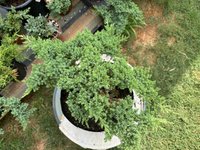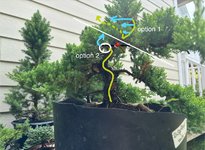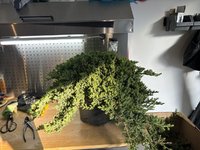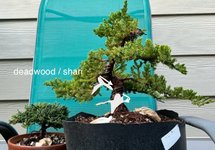D
You are using an out of date browser. It may not display this or other websites correctly.
You should upgrade or use an alternative browser.
You should upgrade or use an alternative browser.
TimIAm
Yamadori
From the last two pictures it's hard to see what the trunk is doing after the lowest branches.
I understand it's a 2D photo so looks can be deceiving, but one helpful design consideration that's helped me in the past is to consider the negative space between your branches when you're looking at the tree from your chosen front. Think about the negative space as a deliberate choice and part of your composition. Think about how the negative space(s) on the left side relate to those on the right. Try and avoid clumps of overlapping branches and then having a big gap above them. Even if the branches are not clumped together from the same side of the trunk, one branch can create this effect with a back branch from a given angle. You need to avoid that from your chosen front.
Another good question is, 'how do my own eyes travel over the composition'. With this tree, my eyes start at the base and then travel straight up and then over to the left as it follows the wired down top branch and then back down to the clump of branches on either side.
What are your future plans for the tree / design? You may already planning an apex or more branches, so my comments may be premature, but you didn't mention. The top just doesn't sit right for me. Maybe if more of the trunk line was exposed, but I still think it needs a little bit extra on the top and maybe something slightly out to the right to balance it out.
I think it's great you are sharing your work and designs. I am a person that likes to dive in and learn by doing and learn by my mistakes. I've seen some harsh feedback, but I think if you can take the constructive feedback and work that into existing and future designs then you will only benefit and you will develop. There are plenty of people on here who can give you some really good insights.
I understand it's a 2D photo so looks can be deceiving, but one helpful design consideration that's helped me in the past is to consider the negative space between your branches when you're looking at the tree from your chosen front. Think about the negative space as a deliberate choice and part of your composition. Think about how the negative space(s) on the left side relate to those on the right. Try and avoid clumps of overlapping branches and then having a big gap above them. Even if the branches are not clumped together from the same side of the trunk, one branch can create this effect with a back branch from a given angle. You need to avoid that from your chosen front.
Another good question is, 'how do my own eyes travel over the composition'. With this tree, my eyes start at the base and then travel straight up and then over to the left as it follows the wired down top branch and then back down to the clump of branches on either side.
What are your future plans for the tree / design? You may already planning an apex or more branches, so my comments may be premature, but you didn't mention. The top just doesn't sit right for me. Maybe if more of the trunk line was exposed, but I still think it needs a little bit extra on the top and maybe something slightly out to the right to balance it out.
I think it's great you are sharing your work and designs. I am a person that likes to dive in and learn by doing and learn by my mistakes. I've seen some harsh feedback, but I think if you can take the constructive feedback and work that into existing and future designs then you will only benefit and you will develop. There are plenty of people on here who can give you some really good insights.
River's Edge
Imperial Masterpiece
Considerations at this point.
Branch length and thickness in relation to trunk thickness and the branches position on the trunk?
Thinning portions to retain healthy foliage near the trunk, pruning apical tips or cutting back to strengthen interior foliage.
Branch length and thickness in relation to trunk thickness and the branches position on the trunk?
Thinning portions to retain healthy foliage near the trunk, pruning apical tips or cutting back to strengthen interior foliage.
Japonicus
Imperial Masterpiece
D
Deleted member 47471
Guest
Much appreciated on the feedback. My plan is to grow primaries and secondaries on the way up the tree and eventually angle them downward and out front/back/left/right like a lampshade.From the last two pictures it's hard to see what the trunk is doing after the lowest branches.
I understand it's a 2D photo so looks can be deceiving, but one helpful design consideration that's helped me in the past is to consider the negative space between your branches when you're looking at the tree from your chosen front. Think about the negative space as a deliberate choice and part of your composition. Think about how the negative space(s) on the left side relate to those on the right. Try and avoid clumps of overlapping branches and then having a big gap above them. Even if the branches are not clumped together from the same side of the trunk, one branch can create this effect with a back branch from a given angle. You need to avoid that from your chosen front.
Another good question is, 'how do my own eyes travel over the composition'. With this tree, my eyes start at the base and then travel straight up and then over to the left as it follows the wired down top branch and then back down to the clump of branches on either side.
What are your future plans for the tree / design? You may already planning an apex or more branches, so my comments may be premature, but you didn't mention. The top just doesn't sit right for me. Maybe if more of the trunk line was exposed, but I still think it needs a little bit extra on the top and maybe something slightly out to the right to balance it out.
I think it's great you are sharing your work and designs. I am a person that likes to dive in and learn by doing and learn by my mistakes. I've seen some harsh feedback, but I think if you can take the constructive feedback and work that into existing and future designs then you will only benefit and you will develop. There are plenty of people on here who can give you some really good insights.
D
Deleted member 47471
Guest
W

Will do, my good sirConsiderations at this point.
Branch length and thickness in relation to trunk thickness and the branches position on the trunk?
Thinning portions to retain healthy foliage near the trunk, pruning apical tips or cutting back to strengthen interior foliage.
NateDyk47
Shohin
Great start! My thoughts:
- I agree with other comments that I'd like to see more of the trunk. It is, however, pretty straight near the base and perfectly vertical. When you eventually repot, I'd change the angle. Do you think the trunk is possible to bend at all? May not be necessary, but could add some interest.
- I like that you removed some of the larger branches. That will definitely help with proportions. I like what Frank said regarding prioritizing interior growth on the remaining branches. Since you already removed a good deal of foliage, it would probably be a good idea to wait a bit on any further pruning.
- What's your design goal for the tree? Do you see it being roughly the same height it is now?
- I agree with other comments that I'd like to see more of the trunk. It is, however, pretty straight near the base and perfectly vertical. When you eventually repot, I'd change the angle. Do you think the trunk is possible to bend at all? May not be necessary, but could add some interest.
- I like that you removed some of the larger branches. That will definitely help with proportions. I like what Frank said regarding prioritizing interior growth on the remaining branches. Since you already removed a good deal of foliage, it would probably be a good idea to wait a bit on any further pruning.
- What's your design goal for the tree? Do you see it being roughly the same height it is now?
D
Deleted member 47471
Guest
D
Deleted member 47471
Guest
Post Spring progress



Design options to place the head over a potential informal upright position:


Unsure at this point if I would prefer a more open composition with mostly visible lines/structure of branching for an open view inside the tree, or a more closed composition with pads covering more branching and partial covering of trunk.



Design options to place the head over a potential informal upright position:


Unsure at this point if I would prefer a more open composition with mostly visible lines/structure of branching for an open view inside the tree, or a more closed composition with pads covering more branching and partial covering of trunk.
Paradox
Marine Bonsologist
Hmm...not sure why you would want to hide the trunk. It's got good movement and taper.
Might want to be careful how long you are letting some of those branches get. I don't think you want to allow them to get much thicker. The proportion of that low branch seems just about right to me
Might want to be careful how long you are letting some of those branches get. I don't think you want to allow them to get much thicker. The proportion of that low branch seems just about right to me
D
Deleted member 47471
Guest
Much appreciated on assessment. I will make cuts in the Fall. Doing so should set up the secondary and tertiary branching for future length/size/proportion.Hmm...not sure why you would want to hide the trunk. It's got good movement and taper.
Might want to be careful how long you are letting some of those branches get. I don't think you want to allow them to get much thicker. The proportion of that low branch seems just about right to me
I would like to ask:
If I want to participate more in placement of multiple secondaries along a primary (before the end portion and bifurcation) I have heard on YouTube that reducing the number of 2ndary foliage growths to just a few pieces and alternating them side to side along the primary (at the locations I would like future branching) is effective.
I am still trying to wrap my head around this concept. By virtue of reducing the number of foliage pieces, will the tree select which of those few remaining bits to mature and grow as woody branches?
I understand pruning back a primary to leave the left/right growth at the end of the branch will create bifurcation and ramification with shorter nodes but what about alternating secondaries coming off the primary? Is it just a matter of foliage reduction so that energy focuses on a certain location to make a new branch?
Paradox
Marine Bonsologist
Much appreciated on assessment. I will make cuts in the Fall. Doing so should set up the secondary and tertiary branching for future length/size/proportion.
I would like to ask:
If I want to participate more in placement of multiple secondaries along a primary (before the end portion and bifurcation) I have heard on YouTube that reducing the number of 2ndary foliage growths to just a few pieces and alternating them side to side along the primary (at the locations I would like future branching) is effective.
I am still trying to wrap my head around this concept. By virtue of reducing the number of foliage pieces, will the tree select which of those few remaining bits to mature and grow as woody branches?
I understand pruning back a primary to leave the left/right growth at the end of the branch will create bifurcation and ramification with shorter nodes but what about alternating secondaries coming off the primary? Is it just a matter of foliage reduction so that energy focuses on a certain location to make a new branch?
By the virtue of the fact that you have reduced the number, YOU have already selected which sub branches the tree should focus on.
You are telling the tree, "I want you to focus growth on these sub branches for secondary growth" so I have removed the others.
You also can (probably should) prune back the tip of that branch a bit to encourage the energy to the ones further back that you left longer
The thing is you hope the tree agrees with you and responds correctly.
D
Deleted member 47471
Guest
August update




Practicing Shari across the grain (on the non-front side of the tree) to learn the outcomes compared to to Shari that twists with the grain. Heard a lot of discussion about it and now I get to see/feel/learn both outcomes (and on the same tree).
Overall, the development and improvement is expedient and all the trees are growing like gangbusters with the very regiment I’m using.




Practicing Shari across the grain (on the non-front side of the tree) to learn the outcomes compared to to Shari that twists with the grain. Heard a lot of discussion about it and now I get to see/feel/learn both outcomes (and on the same tree).
Overall, the development and improvement is expedient and all the trees are growing like gangbusters with the very regiment I’m using.
D
Deleted member 47471
Guest
October 2024
Raffia applied, heavy wire, structural improvement established, creation of negative space, and assembly of triangulation with foreground, middleground, and background branching/foliage. Internal structure and scaffolding made visible.




Feels natural and easy to understand creating left, right, back branching/foliage, depth on all plains, and overall shape upon first iterations. Still working on perfecting the wiring and with complicated internal structure.
Raffia applied, heavy wire, structural improvement established, creation of negative space, and assembly of triangulation with foreground, middleground, and background branching/foliage. Internal structure and scaffolding made visible.




Feels natural and easy to understand creating left, right, back branching/foliage, depth on all plains, and overall shape upon first iterations. Still working on perfecting the wiring and with complicated internal structure.
River's Edge
Imperial Masterpiece
How do you feel about the planting angle? Thoughts on flow, unity and proportions? Always lots to consider. Then there is dynamics, does the initial movement favour a static pose or should one add some tension. Any clear characteristics in the nebari to add to the blender? Perhaps some stray thoughts to consider.
D
Deleted member 47471
Guest
Definitely a lot to consider. I have tilted left to consider a position change. I think it could work and easily adapt.How do you feel about the planting angle? Thoughts on flow, unity and proportions? Always lots to consider. Then there is dynamics, does the initial movement favour a static pose or should one add some tension. Any clear characteristics in the nebari to add to the blender? Perhaps some stray thoughts to consider.
In terms of root and nebari development, would I build the soil up to cover what is currently visible and grow it out a few years? Much of the surface is exposed.
River's Edge
Imperial Masterpiece
The shape and position of strong roots should be considered when determining planting angle and the appropriate initial movement in the design. That is what I was alluding to for consideration. How you decide tp present the nebari is a major factor!Definitely a lot to consider. I have tilted left to consider a position change. I think it could work and easily adapt.
In terms of root and nebari development, would I build the soil up to cover what is currently visible and grow it out a few years? Much of the surface is exposed.
The pictures presented are a bit difficult to view the nebari clearly or have a sense of the 360 options that might be present.
Juniper are highly prized for movement, shari and deadwood with considerable flow and unity between live veins and deadwood.
Sometimes a group of pictures showing all sides can be very useful to interpret what is happening. It might just be my aged eyesight but the jagged edge of the pot seems to prevent a clear view and dark shadows. perhaps it is just the lighting. A lamp higher up and nearby may reveal a lot of detail that shows interesting movement within the trunk and nebari that could lend to improving the design. on the other hand it may show that what you have is much better than it appears.
I raised the concepts to encourage you to consider those points. You are in the best position to assess and decide. I also thought it would round out the discussion for others reading the thread and considering their own trees! It is ok to be happy with the approach that make sense to you!
Similar threads
- Replies
- 3
- Views
- 517
- Replies
- 8
- Views
- 875
- Replies
- 43
- Views
- 4K










